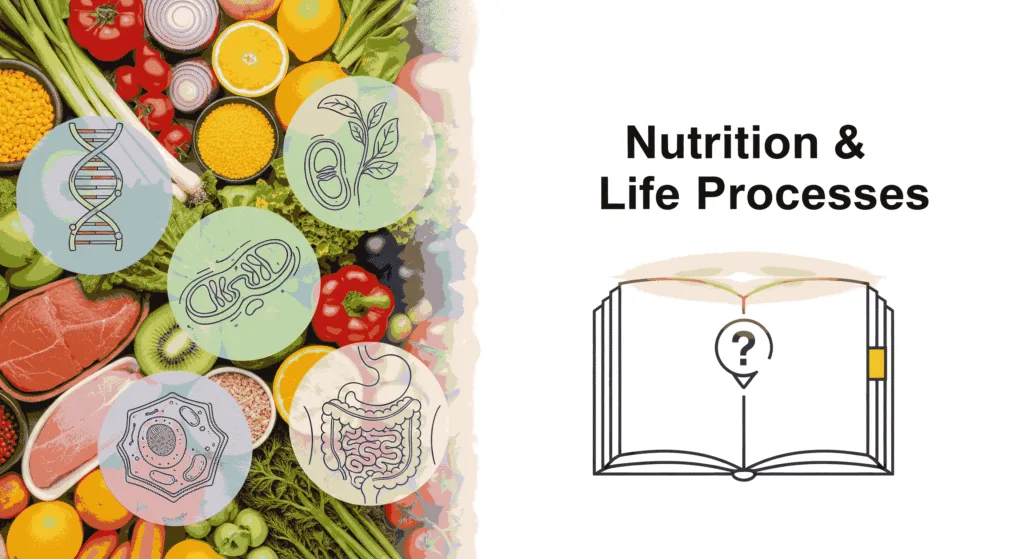
“Nutrition In Human Beings 50 Short Answer Questions” is a collection of all the possible questions that CBSE can ask from your NCERT Sciecne book chapter 5. We have tried to make out as many questions as possible. Past year question papers were also condulted to present before you 50 Nutrition In Human Beings from Life Processes chapter.
After learning the below questions, practice the MCQs Quiz – Nutrition in Human Beings MCQ Quiz
Question 1. What is the basic structure of the alimentary canal?
Answer: A long tube extending from the mouth to the anus.
Question 2. What is the initial processing step food undergoes once it enters the body?
Answer: Crushing with teeth to generate small particles of the same texture.
Question 3. What is the fluid secreted by the salivary glands called?
Answer: Saliva.
Question 4. What is the primary function of salivary amylase?
Answer: To break down starch, a complex molecule, into simple sugar.
Question 5. How is food moved around the mouth while chewing?
Answer: By the muscular tongue.
Question 6. What are the rhythmic contractions of muscles in the lining of the alimentary canal called, which push food forward?
Answer: Peristaltic movements.
Question 7. Through which structure is food taken from the mouth to the stomach?
Answer: Food-pipe or oesophagus.
Question 8. How does the stomach help in mixing food thoroughly with digestive juices?
Answer: Through the action of its muscular walls.
Question 9. Which glands are present in the wall of the stomach and are responsible for digestion there?
Answer: Gastric glands.
Question 10. What three substances do the gastric glands release?
Answer: Hydrochloric acid, pepsin, and mucus.
Question 11. What is the function of hydrochloric acid in the stomach?
Answer: To create an acidic medium which facilitates the action of the enzyme pepsin.
Question 12. Which substance protects the inner lining of the stomach from the action of acid under normal conditions?
Answer: Mucus.
Question 13. What regulates the exit of food from the stomach into the small intestine?
Answer: A sphincter muscle.
Question 14. Why is the small intestine described as being fitted into a compact space?
Answer: Due to extensive coiling.
Question 15. How does the length of the small intestine differ between herbivores and carnivores?
Answer: Herbivores need a longer small intestine, while carnivores have a shorter one.
Question 16. What is considered the site of the complete digestion of carbohydrates, proteins, and fats?
Answer: Small intestine.
Question 17. Which two organs secrete substances into the small intestine to aid digestion?
Answer: Liver and pancreas.
Question 18. Why does the food coming from the stomach need to be made alkaline in the small intestine?
Answer: For the pancreatic enzymes to act.
Question 19. What accomplishes making the food alkaline in the small intestine, in addition to acting on fats?
Answer: Bile juice from the liver.
Question 20. How do bile salts aid in the digestion of fats?
Answer: They break large fat globules down into smaller globules, increasing the efficiency of enzyme action.
Question 21. What is the process called when bile salts break down large fat globules into smaller ones, similar to how soaps act on dirt?
Answer: Emulsifying action.
Question 22. What enzymes are contained in the pancreatic juice secreted by the pancreas?
Answer: Trypsin for digesting proteins and lipase for breaking down emulsified fats.
Question 23. What do the walls of the small intestine contain that secrete intestinal juice?
Answer: Glands.
Question 24. What are the final products of protein digestion by enzymes in the small intestine?
Answer: Amino acids.
Question 25. What are the final products of complex carbohydrate digestion by enzymes in the small intestine?
Answer: Glucose.
Question 26. What are the final products of fat digestion by enzymes in the small intestine?
Answer: Fatty acids and glycerol.
Question 27. How is digested food taken up by the walls of the intestine?
Answer: Via numerous finger-like projections called villi.
Question 28. What is the function of villi in the small intestine?
Answer: To increase the surface area for absorption.
Question 29. What are villi richly supplied with, to take absorbed food to every cell of the body?
Answer: Blood vessels.
Question 30. What are the main uses of absorbed food in the body?
Answer: Obtaining energy, building up new tissues and the repair of old tissues.
Question 31. What happens to unabsorbed food after passing through the small intestine?
Answer: It is sent into the large intestine.
Question 32. What is the primary function of the large intestine?
Answer: To absorb more water from the unabsorbed material.
Question 33. How is the rest of the unabsorbed material removed from the body?
Answer: Via the anus.
Question 34. What regulates the exit of waste material from the body?
Answer: The anal sphincter.
Question 35. What type of food processing needs to be done to generate particles which are small and of the same texture?
Answer: Mechanical crushing.
Question 36. Why is the food wetted before passage through the alimentary canal?
Answer: To make its passage smooth, as the lining of the canal is soft.
Question 37. What are biological catalysts that help break down complex food molecules into smaller molecules for absorption?
Answer: Enzymes.
Question 38. Why is it necessary to move the food in a regulated manner along the digestive tube?
Answer: So that it can be processed properly in each part.
Question 39. What describes the stomach when food enters it?
Answer: It expands.
Question 40. What enables the protein-digesting enzyme pepsin to function effectively in the stomach?
Answer: An acidic medium created by hydrochloric acid.
Question 41. What common complaint among adults is related to the discussion of stomach acid?
Answer: Acidity.
Question 42. Why do herbivores need a longer small intestine than carnivores?
Answer: To allow cellulose to be digested.
Question 43. What is the primary role of bile juice from the liver, besides making food alkaline?
Answer: Acting on fats.
Question 44. Which enzyme in pancreatic juice is responsible for digesting proteins?
Answer: Trypsin.
Question 45. Which enzyme in pancreatic juice is responsible for breaking down emulsified fats?
Answer: Lipase.
Question 46. What is the purpose of the extensive coiling of the small intestine?
Answer: To fit the longest part of the alimentary canal into a compact space.
Question 47. If the villi in the small intestine were fewer in number or flatter, how would absorption be affected?
Answer: Absorption would decrease due to a reduced surface area.
Question 48. Which of the following is NOT a product of digestion absorbed from the small intestine?
Answer: Cellulose.
Question 49. What is the overall goal of the digestive process in human beings, as described in the sources?
Answer: To break down complex ingested food into smaller molecules for absorption and utilization.
Question 50. What is the primary difference in digestion that necessitates different small intestine lengths in herbivores versus carnivores?
Answer: The varying difficulty in digesting cellulose versus meat.
Conclusion: Nutrition In Human Beings 50 Short Answer Questions
Hope you liked the Q & A.
Revision is the key to scoring good marks in the exam, and what better way to do revision than by solving questions? BUt before that you have to learn and undestand the chapter thoroughly.
Read the chapter explanation and short notes of Life Processes on our website and clear your exam with flying colors.

![[2025] Federalism Explained! : Brilliant & Game-Changer – Master India’s Power-Sharing Secrets for Class 10](https://studyless.in/wp-content/uploads/2025/04/100-MCQs-ON_11zon-1024x576.avif)


